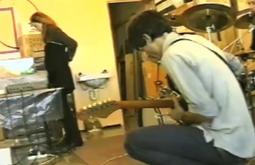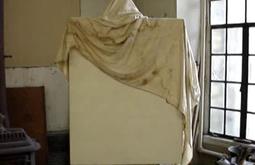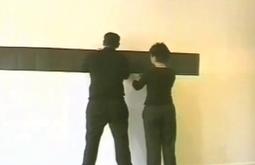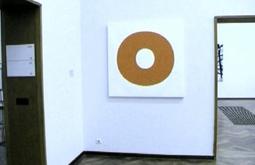Dashper discusses his painting The grey in Grey Lynn, and the particular decision to leave a strip of masking tape on the paintings surface. He presents numerous examples to camera of other paintings which he describes as “not working”. He discusses his method of leaving the protective plastic wrap on some of his paintings when they are hung for display, and what interests him generally about The grey in Grey Lynn. Offscreen we occasionally hear questions from Jim Barr.
Long Description
Dashper walks into studio space. On the wall at left is a paper work with the text DRIVE RINSO. In the centre of the room is a red chair. Leaning against the wall at right is the painting later identified as Understanding tooth decay.
Dashper greets camera, he identifies the date/time as 9.59am on Friday 20 November 1989, and hangs another painting. Voice of Jim Barr: “I think we should start again… all this stuffs on camera”. Dashper insists they continue.
Dashper brings in a plastic covered painting he calls The Purple headed mountain and hangs it on the wall. Dashper: “I think I like it more with the plastic on”. Dashper invites Jim to ask him questions. Jim asks if he will show his paintings with the plastic on—“nobody knows anymore”. Dashper says “good question” and begins to unwrap The grey in Grey Lynn. Jim asks would Dashper have a sign on the back saying 'do not unwrap the work?' Dashper replies “that would be defacing the work”. Jim asks him what he’d say if he saw one of his paintings hung in a gallery without the plastic. Dashper smiles and says “you’ve hung that painting badly”.
Jim suggests the video tape recording would have to be “severely edited”. Dashper replies “No Jim, that was not part of the deal”.
Jim asks is the painting finished, noting that it doesn’t look finished as the masking tape is still on. Dashper replies; “That’s what this painting is about. This painting is about…implication of tension… I like the idea of the painting being destroyed by the kids while the parents are away also”. Jim: “By taking the masking tape off?” Dashper: “Yeah.”
Jim expresses doubt anyone will be able to hear what’s on the video tape. Dashper asks “How long is the tape?” Jim replies “3 hours”. Dashper; "Well that’s alright".
Dashper brings in another large painting which he describes as “a failure”. He takes that off camera and brings in another painting which resembles The grey in Grey Lynn, which he sits on the floor below the wall-hung work. He checks the view through the video camera and says “Both in, looking good”.
He removes the tape from the work on the floor, curls it into a ball. Dashper: “As David Salle would say "'this painting is about this'" and throws the tape on the floor. He describes the painting on the floor as a good example of a painting not working—“This paintings got nothing, it’s dead”. He brings in another painting Three Bananas which he describes as almost working but not close enough.
Jim asks if he paints over the top over failed works, Dashper replies he takes the canvas off completely.
Dashper shows a series of preparatory studies on paper for The grey in Grey Lynn. He talks about his titling confusing his audience as the titles indicate a series but “there’s only one representative of each series each time”.
He shows his painting The Nude Staircase, which he says was titled by John Reynolds, and notes “the plastic stays on.” Jim asks “will the tape dry and fall off?” Dashper says yes and that either he or a conservator will glue it back on. Dashper talks about Julian Schnabel leaving masking tape on a painting for 20 years, and the longevity of the tape adhesive, the notion of 'willful obsolescence' and 'archival failure.'
Talking about The grey in Grey Lynn he says he is interested that people “know there’s a straight line under the tape” and “people are denied access to it..." “(they’re) buying into what they think the painting is about”. “I’m the only person who knows what’s underneath it, they’re not going to take it off because they don’t know if it’s part of the artwork… only I know that and I’m saying it is part of the artwork”.
He describes The grey in Grey Lynn as having “6-7 layers of gesso” and “1 coat of grey liquitex”.
He says the masking tape gives “a suggestion of a complete space…when in fact it’s anything but”. He says the corner of the painting suggests the work is “…unfinished when it is known to be finished.” He says leaving the corner exposed is because “I am interested in how the painting works an object rather than as a painting.” He says The grey in Grey Lynn "tells you a lot about the process of making the work, of building the painting, working on the painting from the object up, things that we know are about painting… this painting wouldn’t work if i took the tape off… it completes the painting.”
He says it interests him that when viewers get close up to the painting they “start monkeying with the tape… it almost makes the painting political because the collector, the art gallery goer is actually capable of destroying the full intention of the work, which is a result of taking the tape off.”
The phone rings, Jim answers; “It’s Neil Dawson”. The camera pans left to show Dashper on the phone, with many paintings, sketches, etc hung on the background wall. Dashper says “Jim Barr is making a video of me talking about tension in paintings“. Dashper reassures Dawson the call should continue. “This is history Neil, it’s all going down on tape”.
Dashper discusses negative reviews of recent shows, and tendency of reviewers to concentrate on who turned up at openings and his weight—“you can understand that a lot more.” He talks about has the show Occupied Zone at Artspace, working with a sign writer—“sub contractors are the future” and the sale of a recent work for “6 grand”. He discusses his recent Peter McLeavey show and mentions upcoming travel to the UK and Australia. He gets the phone number of Melbourne dealer Lou Ba Bilu (?) He discusses criticism of Neil’s recent work.
After the phone call Dashper returns the original studio set up and continues to discuss The grey in Grey Lynn. He talks about leaving tape on the canvas as implying the work is “a) unfinished, b) capable of being further finished or c) … a signal that the line was about something else.” He discusses the implication that the work uses “expressionist mannerisms”. He says he “didn’t set out to leave the tape on”. He says the line combines hard edge and expressionist brushwork “to become “complimentary.” He says there is doubt as to whether removing the tape would leave a perfectly straight line, and talks about people asking the question of whether his paintings are ‘finished’. He describes the painting as having "implied volume", due to the unfilled space of raw canvas, which intensifies the rest of the painting and “intimates a sense of the painting as an object”.
He talks about signing the back of the painting. He describes The grey in Grey Lynn as being titled by Tony Green. He says “I often give a painting a ‘studio name’ then give it an ‘art gallery name’’’. He is interested in using a studio name as a final title.
He talks about suggestion of colour in The grey in Grey Lynn, and describes it as a painting that suggests a state of flux, addressing “what you already know about contemporary art history and what you think the painting should do.” He talks about the likelihood of the painting’s physical composition changing over time, and the buyers assumption that it will be exactly the same in 30 years time. He refers to Barnett Newman leaving the tape on his paintings.
Dashper decides to end the conversation at 10.45am. He explains he “wasn’t really warmed up today”, he didn’t have time to do his Jake La Motta impersonation but could do “his Art New Zealand (impression?)” and shows “my skinny belt which I bought in Naples when I lost all that weight.”
He describes how he would have liked to talk about showing The grey in Grey Lynn in other galleries; the height of the hanging; the titling; getting “other artists, academics, interested art historians and curators to title the work.” He talks about the personification of the abstract as “something I would have shied away from years ago.”He talks about “what we know about abstraction” and says this is “probably a good point to end on.”
Tape ends.



